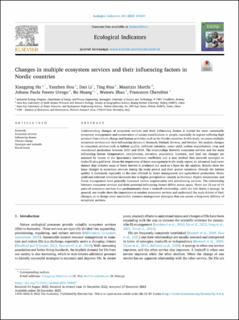| dc.contributor.author | Hu, Xiangping | |
| dc.contributor.author | Hou, Yanzhen | |
| dc.contributor.author | Li, Dan | |
| dc.contributor.author | Hua, Ting | |
| dc.contributor.author | Marchi, Maurizio | |
| dc.contributor.author | Urrego, Johana Paola Forero | |
| dc.contributor.author | Huang, Bo | |
| dc.contributor.author | Zhao, Wenwu | |
| dc.contributor.author | Cherubini, Francesco | |
| dc.date.accessioned | 2023-02-09T12:55:17Z | |
| dc.date.available | 2023-02-09T12:55:17Z | |
| dc.date.created | 2022-12-31T18:29:08Z | |
| dc.date.issued | 2022 | |
| dc.identifier.citation | Ecological Indicators. 2022, 146 . | en_US |
| dc.identifier.issn | 1470-160X | |
| dc.identifier.uri | https://hdl.handle.net/11250/3049734 | |
| dc.description.abstract | Understanding changes of ecosystem services and their influencing factors is crucial for more sustainable ecosystem management and conservation of nature contributions to people, especially in regions suffering high pressure from climate change and human activities, such as the Nordic countries. In this study, we assess multiple ecosystem services and their influencing factors in Denmark, Finland, Norway, and Sweden. We analyze changes in ecosystem services such as habitat quality, sediment retention, water yield, carbon sequestration, crop and roundwood production between 2003 and 2018. The relationships between ecosystem services and the main influencing factors (temperature, precipitation, elevation, population, livestock, and land use change) are assessed by means of the Spearman’s correlation coefficient and a new method that unravels synergies or tradeoffs at a grid level. Given the importance of forest management in the study region, an advanced land cover dataset that includes maps of forest harvest is produced and used as a basis for the analysis. Results show the large changes in ecosystem services during the study period and their spatial variations. Overall, the habitat quality is decreased, especially in the sites affected by forest management and agricultural production. Water yield and sediment retention increased due to higher precipitation (mainly in Norway). Higher temperature and forest management have generally increased carbon sequestration and provisioning services. The relationship between ecosystem services and their potential influencing factors differs across space. There are 10 out of 15 pairs of ecosystem services that predominantly show a tradeoff relationship, while the rest shows a synergy. In general, our results show the importance to monitor ecosystem services and understand the main drivers of their changes, so to design more sustainable resource management strategies that can secure a long-term delivery of ecosystem services. | en_US |
| dc.language.iso | eng | en_US |
| dc.publisher | Elsevier | en_US |
| dc.rights | Navngivelse 4.0 Internasjonal | * |
| dc.rights.uri | http://creativecommons.org/licenses/by/4.0/deed.no | * |
| dc.title | Changes in multiple ecosystem services and their influencing factors in Nordic countries | en_US |
| dc.title.alternative | Changes in multiple ecosystem services and their influencing factors in Nordic countries | en_US |
| dc.type | Peer reviewed | en_US |
| dc.type | Journal article | en_US |
| dc.description.version | publishedVersion | en_US |
| dc.source.pagenumber | 13 | en_US |
| dc.source.volume | 146 | en_US |
| dc.source.journal | Ecological Indicators | en_US |
| dc.identifier.doi | 10.1016/j.ecolind.2022.109847 | |
| dc.identifier.cristin | 2098427 | |
| dc.relation.project | Norges forskningsråd: 286773 | en_US |
| dc.relation.project | Norges forskningsråd: 294534 | en_US |
| cristin.ispublished | true | |
| cristin.fulltext | original | |
| cristin.qualitycode | 1 | |

